Page 335 of 422
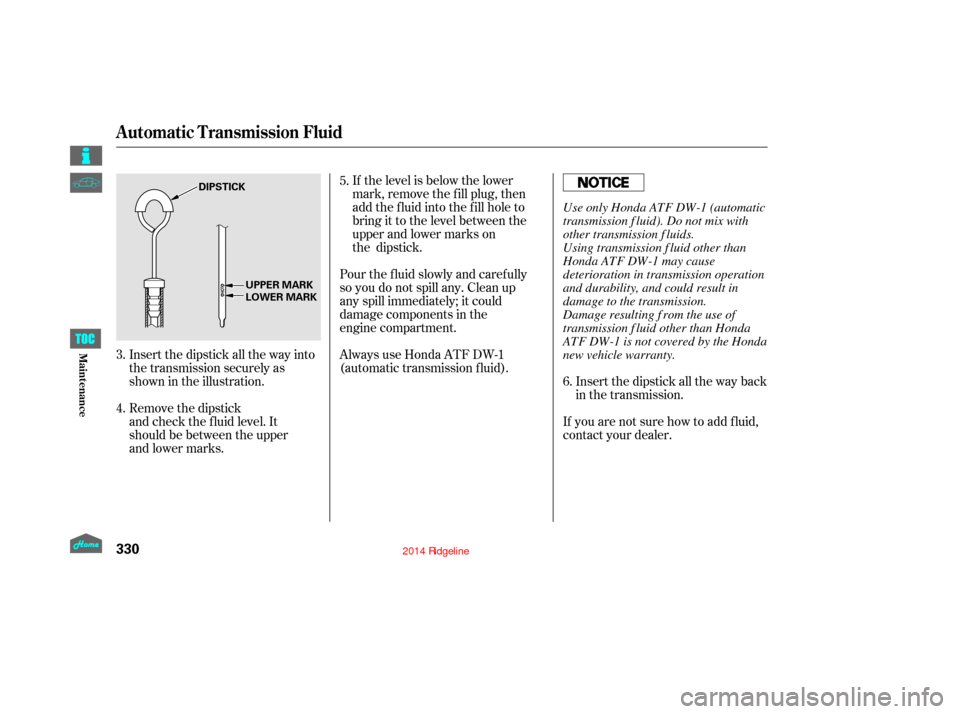
Insert the dipstick all the way back
in the transmission.
If you are not sure how to add f luid,
contact your dealer.
If the level is below the lower
mark, remove the fill plug, then
add the fluid into the fill hole to
bring it to the level between the
upper and lower marks on
the
dipstick.
Pour the fluid slowly and carefully
so you do not spill any. Clean up
any spill immediately; it could
damage components in the
engine compartment.
Insert the dipstick all the way into
the transmission securely as
shown in the illustration.
Remove the dipstick
and check the fluid level. It
should be between the upper
and lower marks. Always use Honda ATF DW-1
(automatic transmission f luid).
6.
5.
3.
4.
Automatic Transmission Fluid
330
DIPSTICK UPPER MARKLOWER MARK
Use only Honda ATF DW-1 (automatic
transmission f luid). Do not mix with
other transmission f luids.
Using transmission f luid other than
Honda ATF DW-1 may cause
deterioration in transmission operation
and durability, and could result in
damage to the transmission.
Damage resulting f rom the use of
transmission f luid other than Honda
ATF DW-1 is not covered by the Honda
new vehicle warranty.
12/08/09 16:42:41 31SJC670_337
Maint enance
Page 337 of 422
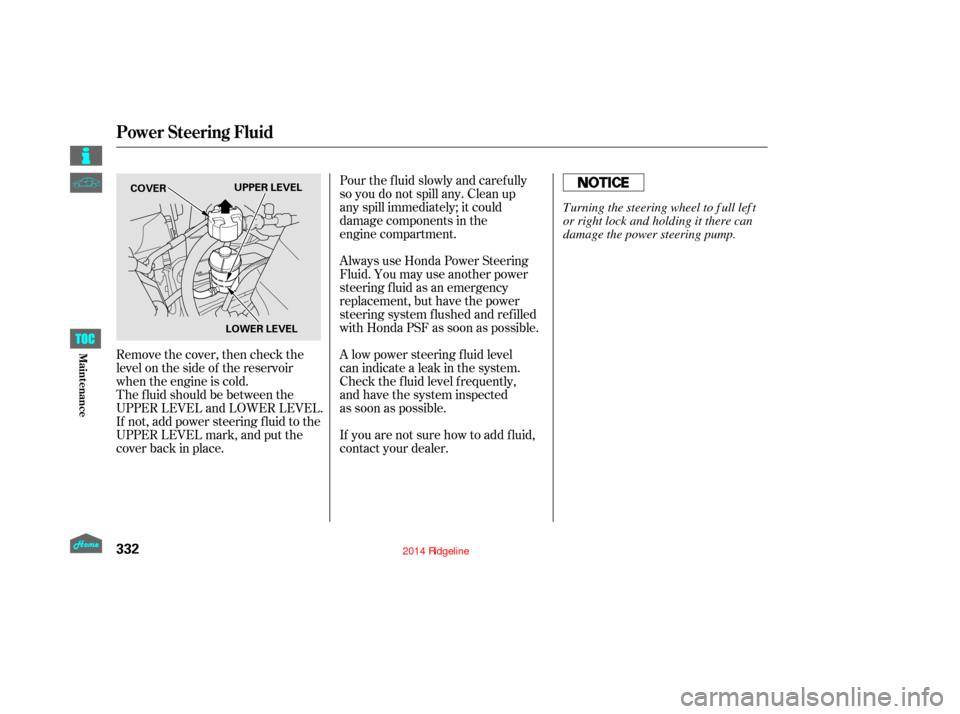
Pour the fluid slowly and carefully
so you do not spill any. Clean up
any spill immediately; it could
damage components in the
engine compartment.
A low power steering fluid level
can indicate a leak in the system.
Check the fluid level frequently,
and have the system inspected
as soon as possible. Always use Honda Power Steering
Fluid. You may use another power
steering f luid as an emergency
replacement, but have the power
steering system f lushed and ref illed
with Honda PSF as soon as possible.
If you are not sure how to add f luid,
contact your dealer.
Remove the cover, then check the
level on the side of the reservoir
when the engine is cold.
The f luid should be between the
UPPER LEVEL and LOWER LEVEL.
If not, add power steering f luid to the
UPPER LEVEL mark, and put the
cover back in place.
Power Steering Fluid
332
LOWER LEVEL
COVER
UPPER LEVEL
Turning the steering wheel to f ull lef t
or right lock and holding it there can
damage the power steering pump.
12/08/09 16:42:54 31SJC670_339
Maint enance
Page 340 of 422
Remove the socket from the
headlight assembly by turning it
one-quarter turn counterclockwise.
Pull the bulb straight out of its
socket. Push the new bulb straight
into the socket until it bottoms.Turn on the lights to make sure
the new bulb is working.
Put the inner f ender cover in place.
Install and lock each holding clip
bypushingonthecenter. Insert the socket back into the
headlight assembly. Turn it
clockwise to lock it in place.
To change the passenger’s side
bulb, start the engine, turn the
steering wheel all the way to the
lef t, and turn of f the engine. To
change the driver’s side bulb, turn
the steering wheel to the right.
Use a f lat-tip screwdriver to
remove the two holding clips f rom
the inner f ender, and pull the inner
f ender cover back. 5.
6.
1.
2. 3.
4.7.
Replacing a Front T urn Signal/
Hazard/Parking L ight Bulb
Lights
335
HOLDING CLIPS
BULB SOCKET
12/08/09 16:43:18 31SJC670_342
Maint enance
Page 360 of 422
Cover the vehicle with a
‘‘breathable’’ cover, one made
f rom a porous material such as
cotton. Non-porous materials, such
as plastic sheeting, trap moisture,
which can damage the paint.
If possible, periodically run the
engine until it reaches full
operating temperature (the
cooling fans cycle on and off
twice). Preferably, do this once
a month.Vacuum dirt and dust f rom the
leather f requently. Pay close
attention to the pleats and seams.
Clean the leather with a sof t cloth
dampened with a 90% water and 10%
neutral soap solution. Then buf f it
with a clean, dry cloth. Remove any
dust or dirt on leather surf aces
immediately. Leather
Vehicle Storage, Interior Care
355
12/08/09 16:46:06 31SJC670_362
Maint enance
Page 362 of 422
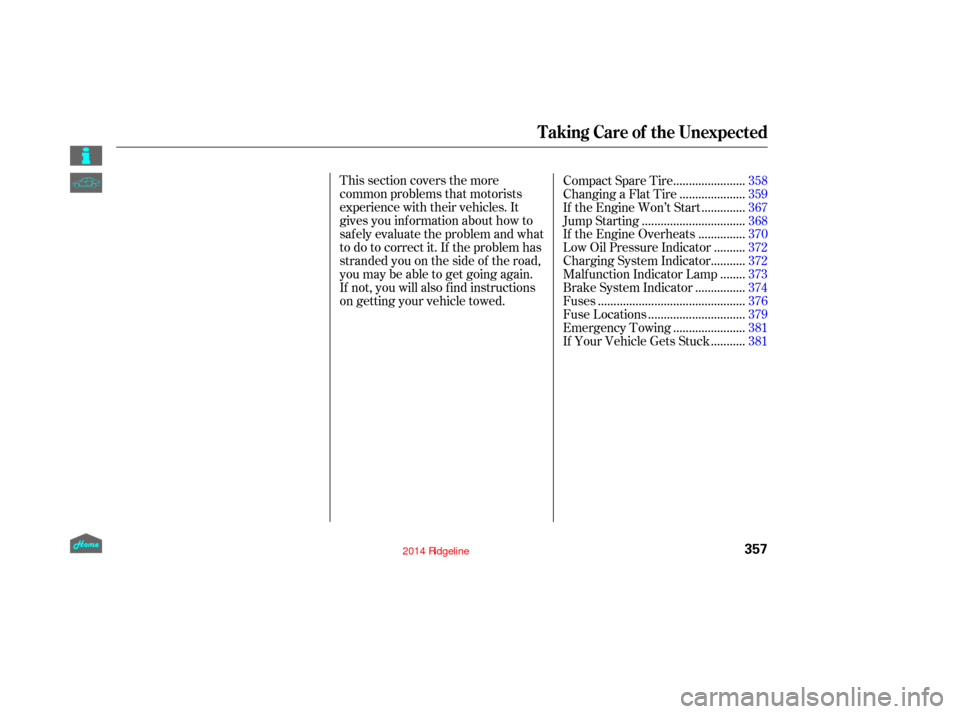
This section covers the more
common problems that motorists
experience with their vehicles. It
gives you inf ormation about how to
safely evaluate the problem and what
to do to correct it. If the problem has
stranded you on the side of the road,
you may be able to get going again.
If not, you will also f ind instructions
on getting your vehicle towed.......................
Compact Spare Tire .358
....................
Changing a Flat Tire .359
.............
If the Engine Won’t Start . 367
................................
Jump Starting .368
..............
If the Engine Overheats . 370
.........
Low Oil Pressure Indicator . 372
..........
Charging System Indicator . 372
.......
Malf unction Indicator Lamp . 373
...............
Brake System Indicator . 374
..............................................
Fuses .376
..............................
Fuse Locations .379
......................
Emergency Towing .381
..........
If Your Vehicle Gets Stuck . 381
Taking Care of the Unexpected
357
12/08/09 16:46:12 31SJC670_364
Page 372 of 422
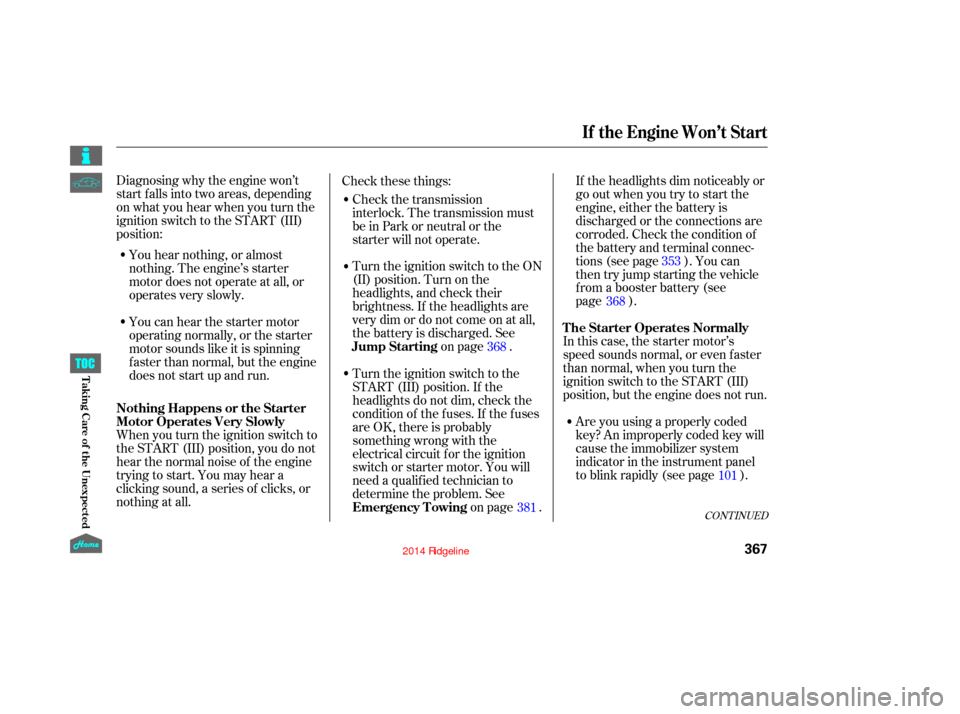
Diagnosing why the engine won’t
start f alls into two areas, depending
on what you hear when you turn the
ignition switch to the START (III)
position:Check the transmission
interlock. The transmission must
be in Park or neutral or the
starter will not operate.
Turn the ignition switch to the ON
(II) position. Turn on the
headlights, and check their
brightness. If the headlights are
very dim or do not come on at all,
the battery is discharged. See
on page . If the headlights dim noticeably or
go out when you try to start the
engine, either the battery is
discharged or the connections are
corroded. Check the condition of
the battery and terminal connec-
tions (see page ). You can
then try jump starting the vehicle
from a booster battery (see
page ).
In this case, the starter motor’s
speed sounds normal, or even f aster
than normal, when you turn the
ignition switch to the START (III)
position, but the engine does not run. Are you using a properly coded
key? An improperly coded key will
cause the immobilizer system
indicator in the instrument panel
to blink rapidly (see page ).
Turn the ignition switch to the
START (III) position. If the
headlights do not dim, check the
condition of the f uses. If the f uses
areOK,thereisprobably
something wrong with the
electrical circuit for the ignition
switch or starter motor. You will
need a qualif ied technician to
determine the problem. See
on page .
Check these things:
When you turn the ignition switch to
the START (III) position, you do not
hear the normal noise of the engine
trying to start. You may hear a
clicking sound, a series of clicks, or
nothing at all. You can hear the starter motor
operating normally, or the starter
motor sounds like it is spinning
f aster than normal, but the engine
does not start up and run. You hear nothing, or almost
nothing. The engine’s starter
motor does not operate at all, or
operates very slowly.
101
368
381 353
368
CONT INUED
Jump Starting T he Starter Operates Normally
Emergency T owing
Nothing Happens or the Starter
Motor Operates Very Slowly
If theEngineWon’tStart
367
12/08/09 16:47:27 31SJC670_374
T aking Care of t he Unexpect ed
Page 373 of 422
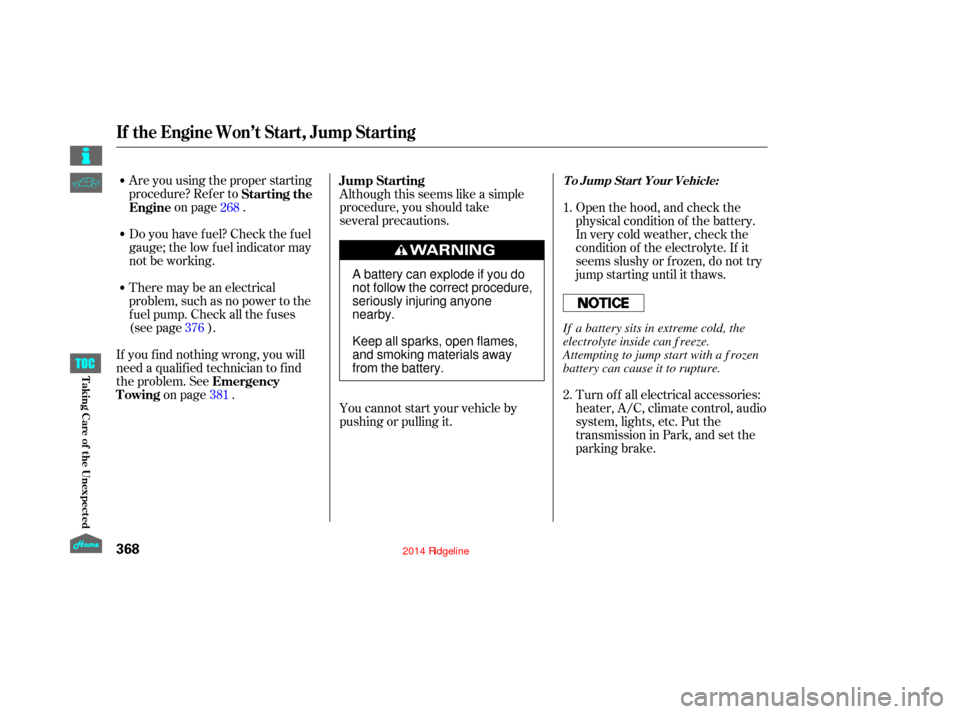
Are you using the proper starting
procedure? Ref er toon page .
There may be an electrical
problem, such as no power to the
f uel pump. Check all the f uses
(see page ).
If youfindnothingwrong,youwill
need a qualif ied technician to f ind
the problem. See on page . Although this seems like a simple
procedure, you should take
several precautions.
You cannot start your vehicle by
pushing or pulling it.
Do you have f uel? Check the f uel
gauge; the low f uel indicator may
not be working.
Turn of f all electrical accessories:
heater, A/C, climate control, audio
system, lights, etc. Put the
transmission in Park, and set the
parking brake. Open the hood, and check the
physical condition of the battery.
In very cold weather, check the
condition of the electrolyte. If it
seems slushy or f rozen, do not try
jump starting until it thaws.
1.
2.
268
376 381 Starting the
Engine
Emergency
Towing Jump Starting
If the Engine Won’t Start, Jump Starting
To Jump Start Your Vehicle:
368
A battery can explode if you do
not follow the correct procedure,
seriously injuring anyone
nearby.
Keep all sparks, open flames,
and smoking materials away
from the battery.
If a battery sits in extreme cold, the
electrolyte inside can f reeze.
Attempting to jump start with a f rozen
battery can cause it to rupture.
12/08/09 16:47:36 31SJC670_375
T aking Care of t he Unexpect ed
Page 374 of 422

�µ
�´ �´ If the booster battery is in another
vehicle, have an assistant start
that vehicle and run it at a fast idle.
Start the vehicle. If the starter
motor still operates slowly, check
that the jumper cables have good
metal-to-metal contact.
Keep the ends of the jumper cables
away from each other and any metal
on the vehicle until everything is
disconnected. Otherwise, you may
cause an electrical short.
Connect the second jumper cable
to the negative ( ) terminal on
the booster battery. Connect the
other end to the grounding strap
as shown. Do not connect this
jumper cable to any other part of
the engine.
Connect one jumper cable to the
positive ( ) terminal on your
vehicle’s battery. Connect the
other end to the positive ( )
terminal on the booster battery.
The numbers in the illustration
show you the order to connect the
jumper
cables. Once your vehicle is running,
disconnect the negative cable f rom
your vehicle, then f rom the
booster battery. Disconnect the
positive cable f rom your vehicle,
then from the booster battery.
4. 6.
7. 5.
3.
Jump Starting
369
BOOSTER BATTERY
12/08/09 16:47:45 31SJC670_376
T aking Care of t he Unexpect ed